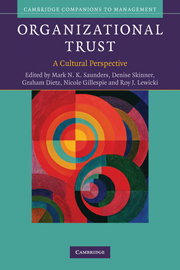Book contents
- Frontmatter
- Contents
- List of figures
- List of tables
- Note on editors
- Note on contributors
- Foreword
- Editors' acknowledgements
- Part I The conceptual challenge of researching trust across different ‘cultural spheres’
- Part II Trust across different ‘cultural spheres’: inter-organizational studies
- 5 Examining the relationship between trust and culture in the consultant–client relationship
- 6 Checking, not trusting: trust, distrust and cultural experience in the auditing profession
- 7 Trust barriers in cross-cultural negotiations: a social psychological analysis
- 8 Trust development in German–Ukrainian business relationships: dealing with cultural differences in an uncertain institutional context
- 9 Culture and trust in contractual relationships: a French–Lebanese cooperation
- 10 Evolving institutions of trust: personalized and institutional bases of trust in Nigerian and Ghanaian food trading
- Part III Trust across different ‘cultural spheres’: intra-organizational studies
- Part IV Conclusions and ways forward
- Index
- References
7 - Trust barriers in cross-cultural negotiations: a social psychological analysis
Published online by Cambridge University Press: 05 June 2012
- Frontmatter
- Contents
- List of figures
- List of tables
- Note on editors
- Note on contributors
- Foreword
- Editors' acknowledgements
- Part I The conceptual challenge of researching trust across different ‘cultural spheres’
- Part II Trust across different ‘cultural spheres’: inter-organizational studies
- 5 Examining the relationship between trust and culture in the consultant–client relationship
- 6 Checking, not trusting: trust, distrust and cultural experience in the auditing profession
- 7 Trust barriers in cross-cultural negotiations: a social psychological analysis
- 8 Trust development in German–Ukrainian business relationships: dealing with cultural differences in an uncertain institutional context
- 9 Culture and trust in contractual relationships: a French–Lebanese cooperation
- 10 Evolving institutions of trust: personalized and institutional bases of trust in Nigerian and Ghanaian food trading
- Part III Trust across different ‘cultural spheres’: intra-organizational studies
- Part IV Conclusions and ways forward
- Index
- References
Summary
Summary
This chapter reviews theory and evidence regarding the barriers to trust that arise within the context of cross-cultural negotiations. The chapter provides an overview of how trust has been conceptualized in the domain of cross-cultural negotiations. It also provides a discussion of the psychological and social barriers to trust common to cross-cultural negotiations. The chapter then discusses approaches to attenuating or overcoming the deleterious effects of these psychological and social barriers. The chapter concludes by discussing some practical implications of the findings, as well as some directions for future research.
Introduction
A central and recurring question in the study of cross-cultural relations has been how best to resolve the unavoidable conflicts that arise between interdependent groups and nations (Kahn and Zald, 1990; Messick and Mackie, 1989; Pruitt and Rubin, 1986; Stephan and Stephan, 1996; Taylor and Moghaddam, 1987). Given the obvious importance of the problem, it is hardly surprising that a variety of approaches have been proposed for dealing with such conflicts, ranging from complex structural interventions to elaborate procedural remedies (Davis et al., 1990; Mares and Powell, 1990). Despite the numerous creative approaches advanced to deal with this problem, negotiation remains one of the most basic and reliable mechanisms for conflict resolution in cross-cultural contexts (Garling et al., 2006; Gelfand and Brett, 2004; Kahn and Kramer, 2006; Leung, 2006).
- Type
- Chapter
- Information
- Organizational TrustA Cultural Perspective, pp. 182 - 204Publisher: Cambridge University PressPrint publication year: 2010
References
- 5
- Cited by



